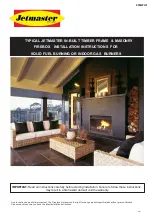
6
4.0
INSTALLATION
4.1 POSITIONING THE STOVE
It is very important to position the stove as close as possible to the chimney, and in an area that will favor the most ef
fi
cient heat
distribution possible throughout the house. The stove must therefore be installed in the room where the most time is spent, and in
the most spacious room possible. Recall that stoves produce radiating heat, the heat we feel when we are close to a stove. A stove
also functions by convection, that is through the displacement of hot air accelerated upwards and its replacement with cooler air. If
necessary, the hot air distribution from the stove may be facilitated by the use of a fan or blower.
• Do not place any combustible material within 4’ (1.2m) of
the front of the unit.
• The clearance between the
fl
ue pipe and a wall are valid only
for vertical walls and for vertical
fl
ue pipe.
• The chimney connector must not pass through an attic or roof
space, closet or similar concealed space, a
fl
oor, or a ceiling.
• For Canadian installations, where passage through a wall,
or partition of combustible construction is desired, the
installation must conform to CAN/CSA-B365.
• A
fl
ue pipe crossing a combustible wall must have a minimum
clearance of 18” (457.2mm).
• To reduce
fl
ue clearances from combustible materials, contact
your local safety department.
Back wall / Arrière Mur
Side wall / P
a
roi Lat
é
rale
Side wall / P
a
roi Lat
é
rale
Sd
e
a
/
a
o
at
éa
e
E
E
D
D
Back wall / Arrièr
e Mur
Ceiling / Plafond
Floor Protector / Protection de Plancher
g
F
G
Back wall / Arrière Mur
Side wall / P
a
roi Lat
é
rale
Side wall / P
a
roi Lat
é
rale
Sd
e
a
/
a
o
a
té
ae
C
B
A
Dimension
Inch
mm
A
Backwall to Stove
12
305
B
Sidewall to Stove
12
305
C
Sidewall to Flue
13
330
D
Wall to Stove (Angled Installation)
8
203
E
Wall to Flue (Angled Installation)
8
203
F
Ceiling Height
84
2133
G
Backwall to Flue
13
330
4.2 FREE STANDING STOVE INSTALLATION
A stove must never be installed in a hallway or near a staircase, since it may block the way in case of
fi
re or fail to respect required
clearances. It is of the utmost importance that the clearances to combustible materials be strictly adhered to during installation of the
stove. Refer to the table and diagrams below for minimum required clearances.
SAFETY NOTICE
IF THIS STOVE IS NOT PROPERLY INSTALLED, A HOUSE FIRE MAY RESULT. TO REDUCE THE RISK OF
FIRE, FOLLOW THE INSTALLATION INSTRUCTIONS.
CONSULT YOUR MUNICIPAL BUILDING DEPARTMENT OR FIRE OFFICIALS ABOUT PERMITS,
RESTRICTIONS AND INSTALLATIONS REQUIREMENTS IN YOUR AREA.
USE SMOKE DETECTORS IN THE ROOM WHERE YOUR STOVE IS INSTALLED.
SMOKE EXPELLED FROM THE UNIT, BY EITHER PAINT CURING, OPENING THE FUEL LOADING DOOR,
OR A NEGATIVE PRESSURE INSIDE THE HOME, COULD TRIGGER THE SMOKE DETECTORS. MOUNT
SMOKE DETECTORS AT LEAST 10’ FROM STOVE
NEVER USE GASOLINE, GASOLINE-TYPE LANTERN FUEL, KEROSENE, CHARCOAL LIGHTER FLUID,
OR SIMILAR LIQUIDS TO START OR “FRESHEN UP” A FIRE IN THIS HEATER. KEEP ALL SUCH LIQUIDS
WELL AWAY FROM THE HEATER WHILE IT IS IN USE.
IN THE EVENT OF A CHIMNEY FIRE, PUSH THE AIR CONTROL FULL CLOSED TO DEPRIVE THE FIRE OF
OXYGEN. CALL THE FIRE DEPARTMENT.
A SOURCE OF FRESH AIR INTO THE ROOM OR SPACE HEATED SHALL BE PROVIDED WHEN REQUIRED.
ROOM HEATER, SOLID FUEL TYPE, ALSO FOR USE IN MOBILE HOMES.
Summary of Contents for SW180
Page 24: ...24 NOTES...







































